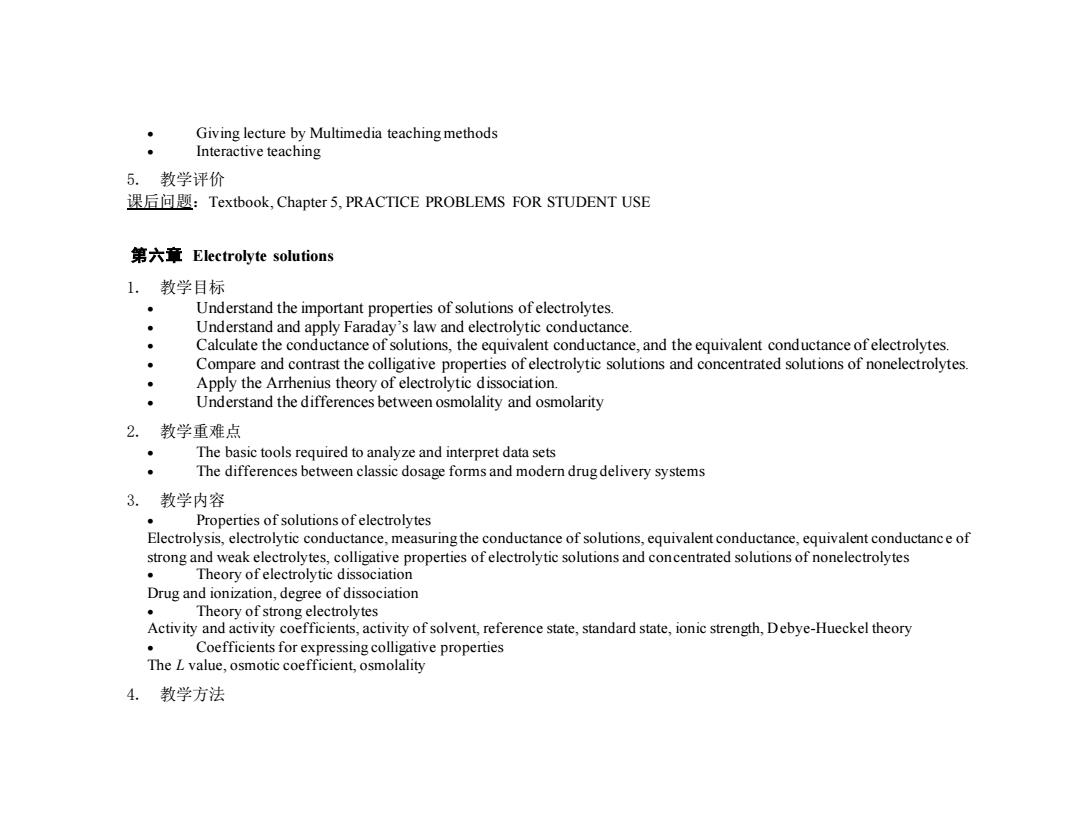正在加载图片...

Giving lecture by Multimedia teaching methods Interactive teaching 5.教学评价 课后间题:Textbook,Chapter5,PRACTICE PROBLEMS FOR STUDENT USE 第六章Electrolyte solutions 1.教学目标 Understand the important properties of solutions of electrolytes. Understand and apply Faraday's law and electrolytic conductance. Calculate the conductance of solutions,the equivalent conductance,and the equivalent conductance of electrolytes. Compare and contrast the colligative properties of electrolytic solutions and concentrated solutions of nonelectrolytes. Apply the Arrhenius theory of electrolytic dissociation. Understand the differences between osmolality and osmolarity 2.教学重难点 The basic tools required to analyze and interpret data sets The differences between classic dosage forms and modern drug delivery systems 3.教学内容 Properties of solutions of electrolytes Electrolysis,electrolytic conductance,measuring the conductance of solutions,equivalent conductance,equivalent conductance of strong and weak electrolytes,colligative properties of electrolytic solutions and concentrated solutions of nonelectrolytes Theory of electrolytic dissociation Drug and ionization,degree of dissociation Theory of strong electrolytes Activity and activity coefficients,activity of solvent,reference state,standard state,ionic strength,Debye-Hueckel theory Coefficients for expressing colligative properties The L value,osmotic coefficient,osmolality 4.教学方法• Giving lecture by Multimedia teaching methods • Interactive teaching 5. 教学评价 课后问题:Textbook, Chapter 5, PRACTICE PROBLEMS FOR STUDENT USE 第六章 Electrolyte solutions 1. 教学目标 • Understand the important properties of solutions of electrolytes. • Understand and apply Faraday’s law and electrolytic conductance. • Calculate the conductance of solutions, the equivalent conductance, and the equivalent conductance of electrolytes. • Compare and contrast the colligative properties of electrolytic solutions and concentrated solutions of nonelectrolytes. • Apply the Arrhenius theory of electrolytic dissociation. • Understand the differences between osmolality and osmolarity 2. 教学重难点 • The basic tools required to analyze and interpret data sets • The differences between classic dosage forms and modern drug delivery systems 3. 教学内容 • Properties of solutions of electrolytes Electrolysis, electrolytic conductance, measuring the conductance of solutions, equivalent conductance, equivalent conductanc e of strong and weak electrolytes, colligative properties of electrolytic solutions and concentrated solutions of nonelectrolytes • Theory of electrolytic dissociation Drug and ionization, degree of dissociation • Theory of strong electrolytes Activity and activity coefficients, activity of solvent, reference state, standard state, ionic strength, Debye-Hueckel theory • Coefficients for expressing colligative properties The L value, osmotic coefficient, osmolality 4. 教学方法